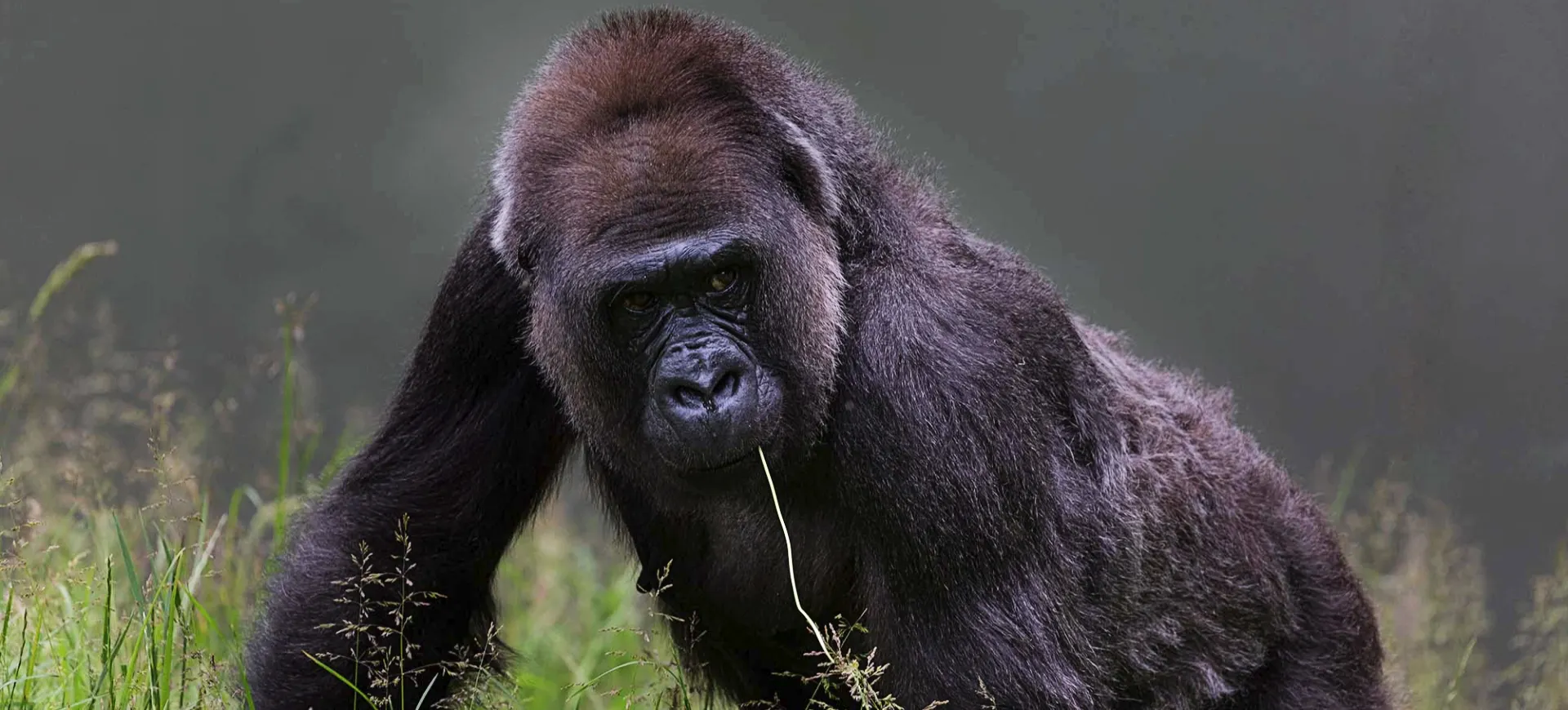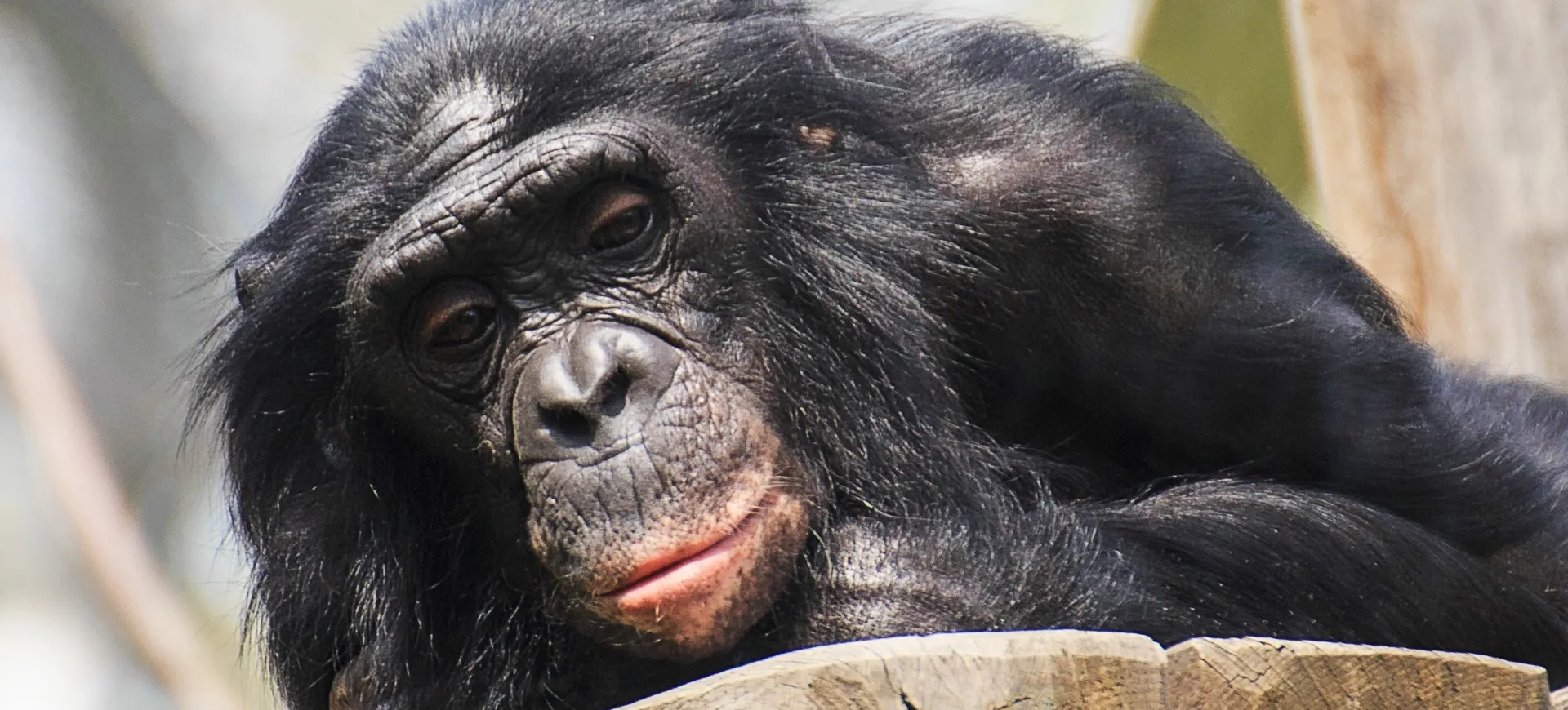Overview
The Common Chimpanzee, also known as the Robust Chimpanzee or simply the Chimpanzee, is a species of great ape native to the forests and savannahs of tropical Africa. It is a member of the Hominidae family, including gorillas, orangutans, bonobos, and humans. Chimpanzees and bonobos are our closest living relatives, sharing approximately 98% of our DNA.
Chimpanzees are highly intelligent and display a range of behaviors, such as using tools, hunting in groups, and intricate social interaction, that were once thought to be uniquely human. They are also known for their physical strength and agility. Chimpanzees are mainly frugivorous but are the most omnivorous of the great apes and will eat various foods.
Unfortunately, chimpanzee populations are declining due to habitat loss, disease, and hunting. Despite numerous conservation efforts, their numbers continue to dwindle, with the species currently classified as endangered.
Physical Description
Chimpanzees are characterized by their robust build, coarse black hair, and facial skin that darkens with age. They possess long arms, shorter legs, opposable thumbs, and big toes, facilitating their arboreal and terrestrial movements. Males are slightly larger and heavier than females and can develop a white beard when they age.
Another characteristic feature of chimpanzees is their large ears, which stick out from the sides of their head. Facial expressions play a significant role in social interactions, with each chimp exhibiting a unique set of expressions.
-

Lifespan:
Wild: ~45 years || Captivity: ~60 years
-

Weight:
Male: 88-132 lbs (40-60 kg) || Female: 57-110 lbs (26-50 kg)
-

Height:
Male: 63 inches (160 cm) || Female: 51 inches (130 cm)
-

Characteristic:
Altricial, Arboreal, Browser, Diurnal, Dominance Hierarchy, Not a Migrant, Omnivore, Polygynandry, Smart Animals, Social, Starts with C, Terrestrial, Territorial, Viviparous, Zoochory
Native Habitat:
Chimpanzees inhabit a range of habitats across tropical Africa. They are found in primary and secondary forests, woodlands, bamboo forests, swamps, and savannas. They are both terrestrial and arboreal, spending equal amounts of time on the ground and in trees.
However, the chimpanzee's habitat is under threat due to deforestation, commercial logging, agriculture, and human settlement expansion. This habitat loss and fragmentation have led to significant declines in chimpanzee populations across their range.
-
Climate Zones:
-
Biomes:
-
WWF Biomes:
-
Biogeographical Realms:
-
Continents:
-
Countries:
-
Diet:
Diet & Feeding Habits:
Chimpanzees are omnivorous, eating a varied diet that includes fruits, leaves, bark, flowers, honey, insects, eggs, and meat. They are the most carnivorous of the great apes and are known to hunt small mammals, such as monkeys, in organized groups. They also display the ability to use tools for feeding, such as sticks for termite fishing and stones to crack nuts.
Their feeding habits play a crucial role in seed dispersal, contributing to the health and diversity of their ecosystems. Foraging often occurs in groups and involves substantial cooperation and sharing, reflecting the complex social structure of chimpanzee communities.
-
Mating Behavior:
Mating Description:
Chimpanzees do not have a specific mating season, and females exhibit sexual swellings to signal their fertility. Males may mate with multiple females, and females may mate with multiple males. This promiscuity is thought to confuse paternity, reducing the risk of infanticide by males.
After a gestation period of approximately eight months, a female chimpanzee gives birth to a single offspring, with twins being a rare occurrence. The young chimp is highly dependent on its mother and will remain with her for up to seven years, learning essential survival skills.
-
Reproduction Season:
Year-Round
-
Birth Type:
-
Pregnancy Duration:
~ 8 months
-
Female Name:
Female
-
Male Name:
Male
-
Baby Name:
Infant
-
Conservation Status:
-
Population Trend:
-
Population:
Wild: ~300,000 || Captivity: ~2,000
Population Description:
The wild population of chimpanzees is estimated to be around 300,000, a significant decrease from the numbers seen a century ago. This decline is primarily due to habitat loss, hunting, disease, and the pet trade.
Chimpanzees are found in zoos, sanctuaries, and research facilities worldwide in captivity. These captive populations serve as ambassadors for their wild counterparts and provide opportunities for research and education.
Population Threats:
The loss of habitat due to deforestation and the expansion of human settlements significantly threatens chimpanzees. Their natural environments are steadily diminishing, leading to a decrease in their numbers and the fragmentation of their populations. Further exacerbating this situation is hunting these animals for bushmeat, which not only reduces their population directly but also disrupts their social structures.
The illegal pet trade also contributes to the dwindling numbers of chimpanzees in the wild. These animals are often captured young, involving the killing of protective mothers, leading to severe demographic imbalances. Diseases, particularly those transmitted from humans, pose another severe threat. Epidemics like the Ebola virus have been known to devastate entire chimpanzee populations, further highlighting the myriad of threats these creatures face.
Conservation Efforts:
Conservation initiatives aimed at safeguarding chimpanzees emphasize protecting and restoring their habitats. This involves establishing protected areas, promoting sustainable land-use practices, and initiatives to curb deforestation. Strengthening and enforcing wildlife laws are critical to preventing illegal activities such as poaching and the pet trade, significantly impacting chimpanzee populations.
Alongside these measures, programs aimed at rehabilitating and reintroducing orphaned and confiscated chimpanzees back into the wild are crucial. These initiatives aid individual animals and contribute to overall population recovery. Public awareness campaigns play a key role in highlighting the threats facing chimpanzees and fostering a sense of responsibility for their preservation. Continued research into these intelligent creatures' behavior and needs is paramount in developing effective conservation strategies and addressing their complex challenges.
Fun Facts
- Chimpanzees are our closest living relatives, sharing about 98% of our DNA.
- They can learn sign language and can understand and express complex thoughts.
- Chimpanzees use tools for various purposes, including feeding, drinking water, and grooming.
- They are known to display empathy and console each other after stressful events.
- Chimpanzees can recognize themselves in a mirror.
- Unlike most other primates, chimpanzees do not have tails.
- They are extremely strong and are estimated to be about 1.5 to 2 times stronger than humans.
- Chimpanzees have a complex system of vocalizations, gestures, and facial expressions to communicate.
- They engage in 'grooming' one another, which helps form social bonds and maintain hygiene.
- Young chimpanzees learn from observing their mothers and other adults, which leads to a 'culture' of behaviors specific to their group.











Social Structure Description:
Chimpanzees live in large, complex communities, known as troops, consisting of up to 150 individuals. These communities have a fission-fusion social structure, meaning they break into smaller, flexible groups (sub-groups or parties) and reassemble over time.
Chimpanzee society is male-dominated, with the highest-ranking male, the alpha male, leading the group. Rank is often established and maintained through displays of aggression and forming strategic alliances.
Groups:
Troop